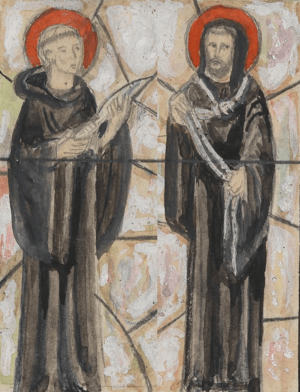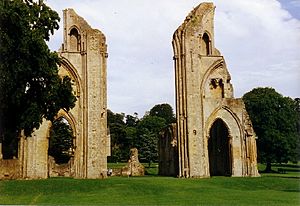Richard Whiting (abbot) facts for kids
Quick facts for kids BlessedRichard Whiting O.S.B. |
|
|---|---|
| Abbot of Glastonbury, Martyr | |
| Born | c. 1461 Wrington, North Somerset, England |
| Died | 15 November 1539 (aged 77 - 78) Glastonbury Tor, Glastonbury, England |
| Honored in | Roman Catholic Church |
| Beatified | 13 May 1895 by Pope Leo XIII |
| Feast | 15 November |
| Attributes | Noose in neck, holding a miniature St. Michael's Church tower from Glastonbury Tor, martyr's palm, pastoral staff |
| Patronage | Glastonbury |
Richard Whiting (born around 1461 – died 15 November 1539) was an English Catholic priest. He was the very last leader, known as an Abbot, of Glastonbury Abbey.
Abbot Whiting was in charge of Glastonbury Abbey during a big change in England. This change was called the Dissolution of the Monasteries (1536–1541). During this time, King Henry VIII of England closed down many monasteries. The King had Abbot Whiting executed for treason because he stayed loyal to the Pope in Rome. The Catholic Church sees him as a martyr, which means someone who died for their faith. He was made a "Blessed" (a step towards sainthood) on May 13, 1895.
Contents
Early Life and Education
Richard Whiting was born near a place called Wrington in England. He grew up and studied at Glastonbury Abbey. Later, he went to the Monk's Hostel at Cambridge University. He earned his Master of Arts degree in 1483.
Becoming the Abbot
Richard Whiting became a deacon in 1500 and a priest in 1501. He went back to Cambridge in 1505 to get his doctor's degree. He also worked at Glastonbury Abbey, helping to manage the monks' living areas.
In 1525, the previous Abbot of Glastonbury, Richard Beere, passed away. The monks chose Richard Whiting to be their new leader. For the first ten years, Whiting's time as Abbot was peaceful and successful. He was a caring spiritual leader and managed the abbey well. People at the time thought very highly of him.
Glastonbury Abbey was one of the richest and most important monasteries in England. About 100 monks lived there. Sons of noble families often studied there before going to university. As Abbot, Whiting was a very important person in the country. He also managed huge areas of land.
Challenges from the King
In 1534, King Henry VIII introduced the Act of Supremacy. This law said that the King, not the Pope, was the head of the Church in England. Abbot Whiting and his monks signed this law at first.
King Henry sent a man named Richard Layton to check on Whiting and the abbey. Layton found everything in good order. However, he took away the Abbot's power over the town of Glastonbury. Whiting was told several times that the abbey would be safe from being closed down. But in 1535, a law was passed to close smaller monasteries. This was a warning of what might happen to Glastonbury.
Abbot Whiting's Death
By January 1539, Glastonbury was the only monastery left in Somerset. Abbot Whiting refused to give up the abbey. It was not covered by the law that closed smaller monasteries.
On September 19, 1539, royal officials arrived at Glastonbury without warning. They were sent by King Henry's chief minister, Thomas Cromwell. They were probably looking for reasons to close the abbey. The officials expected to find a lot of treasure but found little. They searched more carefully and found money and valuable items hidden in vaults. There were also rumors that other treasures had been moved to different abbey properties.
Abbot Whiting, who was old and weak, was sent to the Tower of London. Cromwell wanted to question him himself. The exact reason for his arrest and execution is not fully clear. However, it was usually called treason.
A French ambassador wrote that Whiting was put in the Tower because officials found a book arguing for Catherine of Aragon, King Henry's first wife.
As a member of the House of Lords, Whiting should have been judged by a special Act of Parliament. But he was executed before Parliament even met. Whiting was sent back to Glastonbury. He arrived in Wells on November 14. A trial likely took place there, and he was found guilty of "robbing Glastonbury church."
The next day, Saturday, November 15, he was taken to Glastonbury with two of his monks. Their names were John Thorne and Roger James. All three were tied to wooden frames and dragged by horses to the top of Glastonbury Tor. This hill overlooks the town. There, they were executed. Abbot Whiting's head was placed over the west gate of the now empty abbey. His body parts were displayed in other towns like Wells, Bath, Ilchester, and Bridgwater.
| Blesseds John Thorne and Roger James O.S.B. |
|
|---|---|

Details of a sketch of a stained glass window for Corpus Christi Church in Weston-super-Mare, England
|
|
| Benedictine Monks, Martyrs | |
| Died | 15 November 1539 Glastonbury Tor, Glastonbury, England |
| Beatified | 13 May 1895 by Pope Leo XIII |
| Feast | 15 November |
| Attributes | Thorne: knife, holding a noose, arrow, book, martyr's palm James: noose in neck |
| Patronage | Glastonbury |
Legacy and Remembrance
- Whiting was made a "Blessed" by Pope Leo XIII on May 13, 1895.
- A novel called The Last Abbot of Glastonbury (1883) was written about him by Augustine David Crake.
- When Frederick Bligh Bond (1864–1945) dug up parts of Glastonbury Abbey, he found bones he thought belonged to Richard Whiting.
See Also
- Hugh Faringdon, the last Abbot of Reading Abbey
- Thomas Marshall, the last Abbot of St John's Abbey, Colchester
- Carthusian Martyrs


